Wednesday, December 21, 2016
The Propane Education & Research Council (PERC) has reported positive results from its 2016 Consumer Education campaign, noting that favorability of propane, as measured by the council, is up 13 points among people who saw the program’s advertisements. After hearing the staff report at its meeting Nov. 2-3, 2016, in Naples, Fla., the council approved an $8.24-million Consumer Education campaign for 2017 aimed at continuing goals to maintain gains in familiarity and favorability of propane. 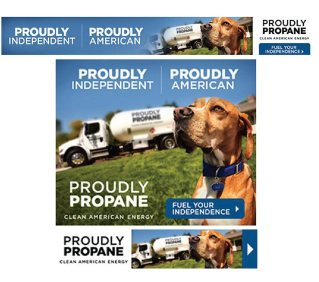
After about six years with no consumer education program, the result of a U.S. Department of Commerce restriction, the council in April unveiled its 2016 Consumer Education initiative featuring a dog named Blue as the main character. PERC chief marketing officer Dennis Vegas, who reported on the 2016 campaign’s results at the November 2016 council meeting, said he was happy to see that the propane industry has embraced Blue and the campaign’s “Proudly Propane” concept.
“We’ve talked with people from coast to coast about the financial investment, personal investment, and sweat-equity investment, and I’m really pleased how marketers have rallied around that ‘Proudly Propane’ statement,” Vegas said.
The 90-day campaign, featuring Blue the dog with his owner, a propane delivery driver, has changed people’s perceptions of propane, Vegas said. He noted that the average consumer sees 5000 media messages per day. “The campaign we created, we believe, certainly broke through that clutter.” The program included advertising on television, radio, print, and the Web.
Campaign ads also appeared in movie theaters, which was effective, Vegas said, adding that the theater ads reached more than 17 million people.
He provided additional statistics showing the success of the program. Familiarity among non-propane users who saw the ads moved up by 16 points. Among propane users who had seen the advertising, willingness to consider buying another propane appliance was 13 percentage points higher. The campaign, he added, generated more favorable perceptions of propane among those who recalled seeing its ads.
Vegas also screened a video illustrating propane marketers’ support for the program. Council member Kasib Abdullah of BP, Susan Martin of Tri-Gas & Oil, and representatives from AmeriGas, Conger LP Gas, and Palmer Gas and Oil spoke on the video in support of the campaign.
Using the same advertising materials that it used in 2016, the 2017 campaign will work toward the goal of maintaining the level of familiarity and favorability that the inaugural effort helped build. Marketers told Vegas they would like to see the ads run for a longer period throughout the year. The 2016 campaign ran from early July to September, with some online presence still remaining through the end of this year. Vegas noted that the longer the campaign is off the air, the likelihood increases that some of the messages will recede from consumers’ minds. PERC will survey marketers, asking when they prefer the ads to run.
Ads ran in media that included television networks such as HGTV, CMT, and Great American Country; print publications such as Time magazine and Midwest Living; and digital media such as Google, Facebook, and YouTube. For 2017, PERC is considering media such as National Geographic and Cooking Light magazines.
Reporting on National Propane Gas Association (NPGA) efforts, association chairman-elect Jerry Brick revealed that NPGA’s executive committee passed a resolution supporting increased research into bio-propane. The consensus view, he said, was that federal and state policy relative to renewable resources will form the basis for most energy policy debates in the future. “We’re already seeing this in our interactions with regulators in California, either in the form of zero-net-energy initiatives or downright mandates,” Brick stated. “The bottom line is it would be very important for us to continue to support our friends at the Western Propane Gas Association and those in other progressive states where regulators are showing disdain for traditional sources of energy like propane.”
NPGA president and CEO Rick Roldan spoke about the benefits of the relationship between PERC and NPGA, mentioning refresher training as an example. NFPA 58 has required marketers to conduct refresher training, “but we’ve never had a clear path to allow them to do that,” Roldan said. Through communication within the NPGA board, the issue went from being controversial to not receiving a single no vote on a refresher program.
“That is a product that marketers have been asking for for some time, and it would not have happened, I believe, were it not for the partnership and the close relationship” between PERC and NPGA, Roldan commented.
He offered cylinder exchange cabinet crash protection as another example. Authorities having jurisdiction across the country were requiring crash protection barriers that would have cost marketers thousands of dollars for every cylinder exchange cabinet. PERC and NPGA worked together to remove the requirement from the International Fire Code and NFPA 58.
“That change alone will save the retail industry in this country tens of millions of dollars just because of that partnership investment,” Roldan said.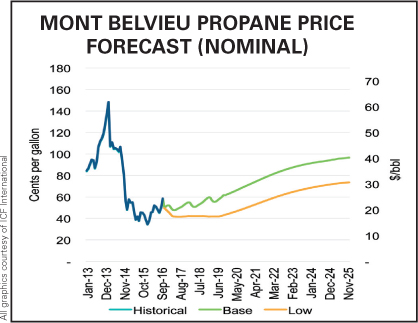
Also at the meeting, Mike Sloan of ICF International gave a presentation titled, “Propane Market Assessment and Housing Market Outlook,” noting that market conditions and lower propane prices provide significant opportunities for the fuel to recapture market share, particularly in markets competing against electricity. That is the case for residential, commercial, forklift, and other sectors.
The opportunity might only last for two to four years, he added, “but it does provide a significant chance for the propane industry to generate market momentum, in part because the housing market is continuing to recover.” The forecast for housing growth is down very slightly relative to where it was about six months ago, but it still reflects roughly 30% growth over the next two years for single-family housing.
Sloan said that although oil prices are low, he has not changed his opinion that the engine fuel market represents the propane industry’s greatest gallon-growing opportunity.
Providing a propane price outlook, he observed that the propane supply environment has changed over the past two to three years and that propane prices are fully integrated with the international market. Propane prices in the U.S. will fall and rise along with prices in the international market. “That will tend to increase volatility and, to a certain degree, increase risk, and it’s something that the propane industry needs to think about and plan for.”
He also provided a 2016-2017 winter outlook, noting that propane inventories were at five-year highs entering the winter but the weather outlook is mixed. A cold winter in the U.S., combined with growth in exports, could lead to rapid inventory drawdown.
Sloan remarked that some forecasts indicate the second half of the winter will be colder than normal, but he does not foresee any major supply issues this winter unless an unusual set of circumstances occurs, such as a very cold winter in Europe that could cause a spike in exports in addition to a very cold winter in North America.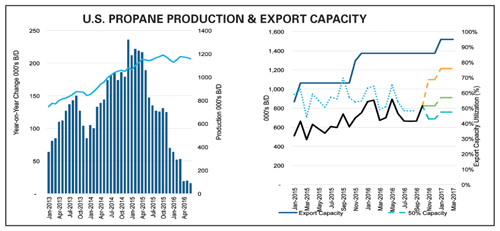
“Right now, we could manage a major spike in exports, for more than 100 days, without getting into a low-inventory condition, with the possible exception of another Polar Vortex,” he noted. “There is slight potential for a tight market at the end of the year, but at this point I think it’s very slight. And that’s a somewhat different forecast than my view in the spring.”
Sloan provided a housing market review for 2015, which he said was the most recent data available. Propane space heating households in the U.S. increased by about 1300 that year, according to a U.S. Census American Community Survey.
“That’s within the margin of error, so I can’t tell you if the number actually went up or down, but that’s what’s being reported,” Sloan said. “I always like to report positive growth as opposed to losses, so it made me smile when the number was above zero.”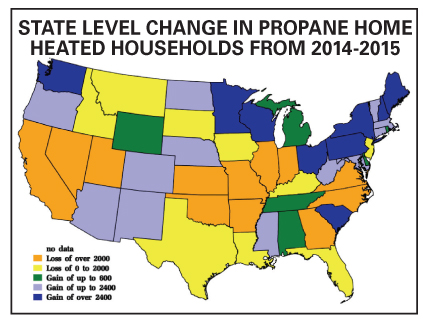
He added that electricity growth is still dominating the market, with a gain of about 1.2 million new households from 2014 to 2015. Most of that was in the southern half of the country in the warmer states. “Natural gas growth is a fraction of electricity, increasing by only 72,000 households, and that surprised me a little bit, given what we hear about the desire for the gas utilities to expand. I thought it would be a little bigger than that.” Fueloil is continuing to decline. “The decline is a little slower than it has been in the past. It’s about 3% to 3.5% of the overall fueloil market. The other change is wood use has slipped. It had been growing for several years, but now it’s dropping.”
PERC approved a budget of $1.5 million for the 2017 Partnership with States (PWS) program. The funds may be spent on any of these qualifying programs: equipment demonstration events; demonstration vehicle purchase and data collection; on-road vehicle incentive program; off-road data collection incentive (the council approved adding forklift projects to this program); construction professionals outreach and training (the council approved a modification to this program to emphasize outreach and training for HVAC and plumbing professionals); safe installation of appliance rebates; Propane Emergencies training; consumer safety messaging; and national consumer education campaign. The council approved the addition of low-emissions technical expertise, which will be eligible for 2017 Partnership funds. Activities include: technical, marketing, research, and non-lobbying agency outreach services related to inclusion of propane equipment, appliances, and vehicles in programs such as, but not limited to, low-carbon fuel standards, zero net energy, and alternative fuels incentives and deployment.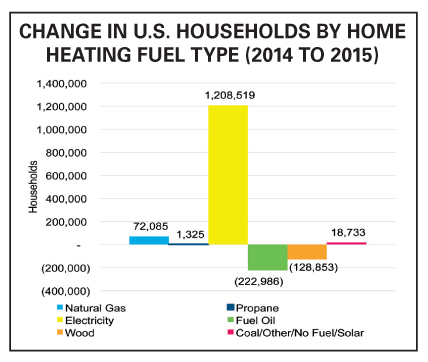
The council allocates state rebate funds and partnership program funds on Oct. 1 of each year. As a result, 2017 PWS funds are being made available now to align with matching state rebate funds. The council considered modifications to the 2017 PSW program in response to a letter from state associations, but turned down a proposal to allow money without matching funds provided by states to be used for certain state staff travel expenses. However, the council tabled discussion and voted to ask the PERC Industry Outreach Committee to review the matching funds requirement for national consumer education campaign support by states.
At issue is whether to allow the use of PWS funds, without the state match, to bolster the national campaign featuring Blue the dog. States currently can use campaign materials with a 1-to-1 match. However, since many states are already committed to other projects and have financial obligations costs locked in, it calls into doubt whether state associations have the resources to tap PSW for additional marketing projects in the coming year. The request to proceed without states ponying up matching funds is aimed at extending the council’s Proudly Propane campaign within the approved $1.5-million PWS budget, while waiving the traditional matching funds requirement of states. The PERC Industry Outreach Committee is scheduled to provide a recommendation to the council at its February meeting.
PERC’s chief business development officer, Tucker Perkins, reported that the council was close to announcing a partnership with material handling company Clark to develop a hybrid propane unit. “It gives us a chance to not only explore new engines, but explore a new package with a forklift itself,” Perkins said.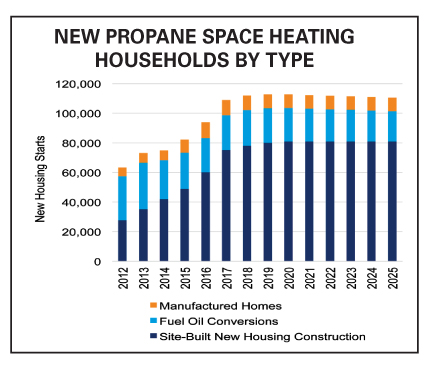
He added that PERC was ready to start a project with modular home builder Nationwide Homes to showcase propane appliances in its showrooms.
Perkins also mentioned that more than 63,000 people have visited the Pull the Plug on Electric Water Heaters site, and more than 11,000 visitors have taken the site’s online quiz titled, “Is a Propane Water Heater for Me?”
PERC director of autogas business development, Michael Taylor, said the U.S. government’s partial settlement with Volkswagen stemming from Clean Air Act violations could create opportunities for propane autogas. Along with compensating owners of select diesel automobiles and offering buybacks and lease terminations, Volkswagen is required to fund a $2.7-billion environmental mitigation trust that will pay for projects to reduce oxides of nitrogen (NOx). The goal is to compensate for the excess NOx from Volkswagen diesel autos by cleaning up diesel emissions from other sources, including school buses, transit buses, large trucks, and freight trains. PERC will work with NPGA and other partners, including manufacturers, to provide information at the state level on the impact that propane autogas can make in reducing NOx per dollar invested in vehicles like school buses. The settlement says that the funds must be spent on the most cost-effective option available, which Taylor noted is a great opportunity for propane autogas. —Daryl Lubinsky

After about six years with no consumer education program, the result of a U.S. Department of Commerce restriction, the council in April unveiled its 2016 Consumer Education initiative featuring a dog named Blue as the main character. PERC chief marketing officer Dennis Vegas, who reported on the 2016 campaign’s results at the November 2016 council meeting, said he was happy to see that the propane industry has embraced Blue and the campaign’s “Proudly Propane” concept.
“We’ve talked with people from coast to coast about the financial investment, personal investment, and sweat-equity investment, and I’m really pleased how marketers have rallied around that ‘Proudly Propane’ statement,” Vegas said.
The 90-day campaign, featuring Blue the dog with his owner, a propane delivery driver, has changed people’s perceptions of propane, Vegas said. He noted that the average consumer sees 5000 media messages per day. “The campaign we created, we believe, certainly broke through that clutter.” The program included advertising on television, radio, print, and the Web.
Campaign ads also appeared in movie theaters, which was effective, Vegas said, adding that the theater ads reached more than 17 million people.
He provided additional statistics showing the success of the program. Familiarity among non-propane users who saw the ads moved up by 16 points. Among propane users who had seen the advertising, willingness to consider buying another propane appliance was 13 percentage points higher. The campaign, he added, generated more favorable perceptions of propane among those who recalled seeing its ads.
Vegas also screened a video illustrating propane marketers’ support for the program. Council member Kasib Abdullah of BP, Susan Martin of Tri-Gas & Oil, and representatives from AmeriGas, Conger LP Gas, and Palmer Gas and Oil spoke on the video in support of the campaign.
Using the same advertising materials that it used in 2016, the 2017 campaign will work toward the goal of maintaining the level of familiarity and favorability that the inaugural effort helped build. Marketers told Vegas they would like to see the ads run for a longer period throughout the year. The 2016 campaign ran from early July to September, with some online presence still remaining through the end of this year. Vegas noted that the longer the campaign is off the air, the likelihood increases that some of the messages will recede from consumers’ minds. PERC will survey marketers, asking when they prefer the ads to run.
Ads ran in media that included television networks such as HGTV, CMT, and Great American Country; print publications such as Time magazine and Midwest Living; and digital media such as Google, Facebook, and YouTube. For 2017, PERC is considering media such as National Geographic and Cooking Light magazines.
Reporting on National Propane Gas Association (NPGA) efforts, association chairman-elect Jerry Brick revealed that NPGA’s executive committee passed a resolution supporting increased research into bio-propane. The consensus view, he said, was that federal and state policy relative to renewable resources will form the basis for most energy policy debates in the future. “We’re already seeing this in our interactions with regulators in California, either in the form of zero-net-energy initiatives or downright mandates,” Brick stated. “The bottom line is it would be very important for us to continue to support our friends at the Western Propane Gas Association and those in other progressive states where regulators are showing disdain for traditional sources of energy like propane.”
NPGA president and CEO Rick Roldan spoke about the benefits of the relationship between PERC and NPGA, mentioning refresher training as an example. NFPA 58 has required marketers to conduct refresher training, “but we’ve never had a clear path to allow them to do that,” Roldan said. Through communication within the NPGA board, the issue went from being controversial to not receiving a single no vote on a refresher program.
“That is a product that marketers have been asking for for some time, and it would not have happened, I believe, were it not for the partnership and the close relationship” between PERC and NPGA, Roldan commented.
He offered cylinder exchange cabinet crash protection as another example. Authorities having jurisdiction across the country were requiring crash protection barriers that would have cost marketers thousands of dollars for every cylinder exchange cabinet. PERC and NPGA worked together to remove the requirement from the International Fire Code and NFPA 58.
“That change alone will save the retail industry in this country tens of millions of dollars just because of that partnership investment,” Roldan said.

Also at the meeting, Mike Sloan of ICF International gave a presentation titled, “Propane Market Assessment and Housing Market Outlook,” noting that market conditions and lower propane prices provide significant opportunities for the fuel to recapture market share, particularly in markets competing against electricity. That is the case for residential, commercial, forklift, and other sectors.
The opportunity might only last for two to four years, he added, “but it does provide a significant chance for the propane industry to generate market momentum, in part because the housing market is continuing to recover.” The forecast for housing growth is down very slightly relative to where it was about six months ago, but it still reflects roughly 30% growth over the next two years for single-family housing.
Sloan said that although oil prices are low, he has not changed his opinion that the engine fuel market represents the propane industry’s greatest gallon-growing opportunity.

Providing a propane price outlook, he observed that the propane supply environment has changed over the past two to three years and that propane prices are fully integrated with the international market. Propane prices in the U.S. will fall and rise along with prices in the international market. “That will tend to increase volatility and, to a certain degree, increase risk, and it’s something that the propane industry needs to think about and plan for.”
He also provided a 2016-2017 winter outlook, noting that propane inventories were at five-year highs entering the winter but the weather outlook is mixed. A cold winter in the U.S., combined with growth in exports, could lead to rapid inventory drawdown.
Sloan remarked that some forecasts indicate the second half of the winter will be colder than normal, but he does not foresee any major supply issues this winter unless an unusual set of circumstances occurs, such as a very cold winter in Europe that could cause a spike in exports in addition to a very cold winter in North America.

“Right now, we could manage a major spike in exports, for more than 100 days, without getting into a low-inventory condition, with the possible exception of another Polar Vortex,” he noted. “There is slight potential for a tight market at the end of the year, but at this point I think it’s very slight. And that’s a somewhat different forecast than my view in the spring.”
Sloan provided a housing market review for 2015, which he said was the most recent data available. Propane space heating households in the U.S. increased by about 1300 that year, according to a U.S. Census American Community Survey.
“That’s within the margin of error, so I can’t tell you if the number actually went up or down, but that’s what’s being reported,” Sloan said. “I always like to report positive growth as opposed to losses, so it made me smile when the number was above zero.”

He added that electricity growth is still dominating the market, with a gain of about 1.2 million new households from 2014 to 2015. Most of that was in the southern half of the country in the warmer states. “Natural gas growth is a fraction of electricity, increasing by only 72,000 households, and that surprised me a little bit, given what we hear about the desire for the gas utilities to expand. I thought it would be a little bigger than that.” Fueloil is continuing to decline. “The decline is a little slower than it has been in the past. It’s about 3% to 3.5% of the overall fueloil market. The other change is wood use has slipped. It had been growing for several years, but now it’s dropping.”
PERC approved a budget of $1.5 million for the 2017 Partnership with States (PWS) program. The funds may be spent on any of these qualifying programs: equipment demonstration events; demonstration vehicle purchase and data collection; on-road vehicle incentive program; off-road data collection incentive (the council approved adding forklift projects to this program); construction professionals outreach and training (the council approved a modification to this program to emphasize outreach and training for HVAC and plumbing professionals); safe installation of appliance rebates; Propane Emergencies training; consumer safety messaging; and national consumer education campaign. The council approved the addition of low-emissions technical expertise, which will be eligible for 2017 Partnership funds. Activities include: technical, marketing, research, and non-lobbying agency outreach services related to inclusion of propane equipment, appliances, and vehicles in programs such as, but not limited to, low-carbon fuel standards, zero net energy, and alternative fuels incentives and deployment.

The council allocates state rebate funds and partnership program funds on Oct. 1 of each year. As a result, 2017 PWS funds are being made available now to align with matching state rebate funds. The council considered modifications to the 2017 PSW program in response to a letter from state associations, but turned down a proposal to allow money without matching funds provided by states to be used for certain state staff travel expenses. However, the council tabled discussion and voted to ask the PERC Industry Outreach Committee to review the matching funds requirement for national consumer education campaign support by states.
At issue is whether to allow the use of PWS funds, without the state match, to bolster the national campaign featuring Blue the dog. States currently can use campaign materials with a 1-to-1 match. However, since many states are already committed to other projects and have financial obligations costs locked in, it calls into doubt whether state associations have the resources to tap PSW for additional marketing projects in the coming year. The request to proceed without states ponying up matching funds is aimed at extending the council’s Proudly Propane campaign within the approved $1.5-million PWS budget, while waiving the traditional matching funds requirement of states. The PERC Industry Outreach Committee is scheduled to provide a recommendation to the council at its February meeting.
PERC’s chief business development officer, Tucker Perkins, reported that the council was close to announcing a partnership with material handling company Clark to develop a hybrid propane unit. “It gives us a chance to not only explore new engines, but explore a new package with a forklift itself,” Perkins said.

He added that PERC was ready to start a project with modular home builder Nationwide Homes to showcase propane appliances in its showrooms.
Perkins also mentioned that more than 63,000 people have visited the Pull the Plug on Electric Water Heaters site, and more than 11,000 visitors have taken the site’s online quiz titled, “Is a Propane Water Heater for Me?”
PERC director of autogas business development, Michael Taylor, said the U.S. government’s partial settlement with Volkswagen stemming from Clean Air Act violations could create opportunities for propane autogas. Along with compensating owners of select diesel automobiles and offering buybacks and lease terminations, Volkswagen is required to fund a $2.7-billion environmental mitigation trust that will pay for projects to reduce oxides of nitrogen (NOx). The goal is to compensate for the excess NOx from Volkswagen diesel autos by cleaning up diesel emissions from other sources, including school buses, transit buses, large trucks, and freight trains. PERC will work with NPGA and other partners, including manufacturers, to provide information at the state level on the impact that propane autogas can make in reducing NOx per dollar invested in vehicles like school buses. The settlement says that the funds must be spent on the most cost-effective option available, which Taylor noted is a great opportunity for propane autogas. —Daryl Lubinsky

